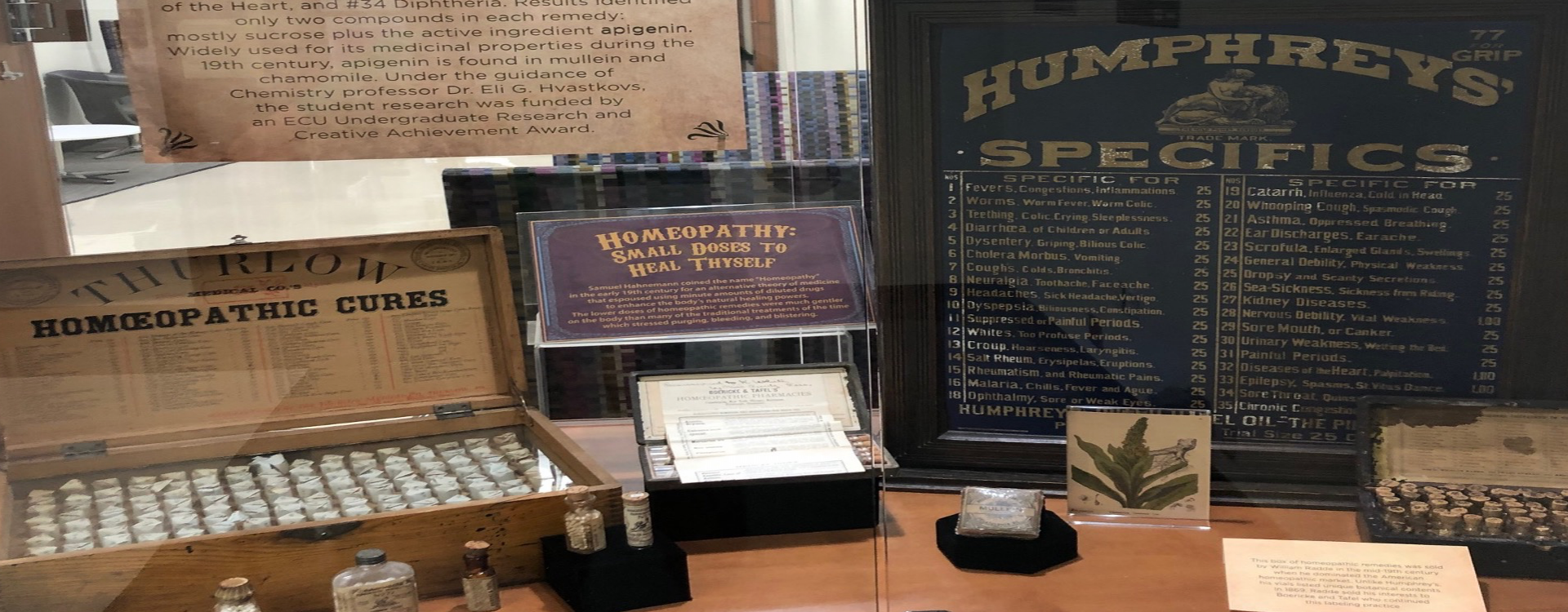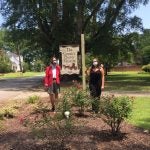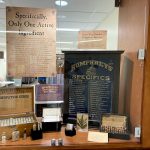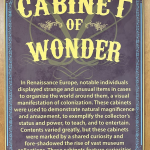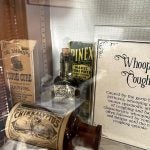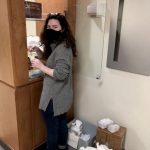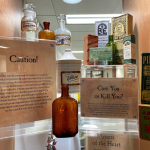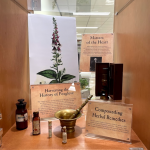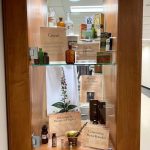SWEET MEDICINE
Research at Country Doctor Museum Leads to Student Publication
Early in 2021, while students were still predominantly participating in remote learning, Harriot College undergraduate and graduate students spent a portion of their academic work on exhibits and research within the Country Doctor Museum, prior to its reopening in May. Rebekah Burroughs (English and History, ’21) interned at the museum, researching instruments and creating exhibits that are displayed at the Brody School of Medicine. Burroughs said it was not a ‘normal’ experience, since the museum was closed to visitors during the internship, but she said she enjoyed working with the collections and exhibits in person.
Chemistry doctoral student Elizabeth LaFave, and a team of undergraduates in a chemistry instrumental lab, conducted chemical analysis research on items at the museum, which recently led to a published article in the International Journal of Historical Archaeology.
LaFave described her research as an interdisciplinary project that used chemically-based techniques to answer historical questions and develop a more complete view of homeopathy during the late 19th century. LaFave and her group analyzed two sets of homeopathic remedies, stating the following:
“The first, Humphreys’ Homeopathic Specifics, was marketed directly to consumers (often sold in pharmacies). Humphreys’ earlier remedies did not contain an ingredients list, so we employed mass spectrometry techniques to identify the components in Humphreys’ remedies,” LaFave said. “In doing so, we also addressed the controversy associated with homeopathic remedies during the time. We gathered period pieces from newspaper advertisements, false advertisement judgments, health insurance statistics and patient testimonies to more fully develop a picture of how our chemical analyses could fit into the atmosphere of debate between allopathy (traditional western medicine) and homeopathy during this period. Overall, we found that although all of Humphreys’ 30+ specifics contained the same basic ingredients, they were not simply ‘sugar pills’ as critics often claimed. Rather, these remedies contained apigenin (as well as a host of other sucrose-related compounds). Apigenin is offered as a modern-day vitamin and has been shown to have medicinal qualities. However, the amount (g/g) of apigenin in Humphreys’ remedies was significantly lower than amounts shown to be beneficial as daily supplements.”
“We have continued this project to include analyses on a second set of homeopathic treatments, Boericke & Tafel,” LaFave said. “Unlike Humphreys’ remedies, these treatments were sold specifically to homeopathic physicians. Additionally, these remedies did have their ingredients listed and were marketed as ‘pure.’ This semester, we are using similar mass spectrometry techniques to 1) validate that the remedy contains what is advertised and that they are ‘pure’ and 2) offer a comparison to Humphreys’ remedies in terms of amount (g/g) of active ingredient to offer evidence towards effectiveness of treatment.”
View photos, descriptions and videos from Burroughs and LaFave’s experiences with the Country Doctor Museum below.
- Elizabeth LaFave and Gerber at the Country Doctor Museum
- Gerber, LaFave and Harrison at the Country Doctor Museum.
- LaFave, Gerber and a Mullein Plant (apigenin).
- LaFave’s completed Humphreys display case.
- Rebekah Burroughs conducted her public history internship at the Country Doctor Museum in spring 2021.
- One of the projects interns worked on is an exhibit in the Brody School of Medicine, with the theme, the “Cabinet of Wonder.”
- While picking out artifacts from storage, Burroughs had to be aware of how long the item would stay in Brody. One of the patent medicines, a little corn plaster in a pretty green paper envelope, was in such good condition. To avoid the potential it would fade on display, and help preserve the artifact, interns scanned the packet and made a duplicate. The original is on the top. The scanned duplicate is on the bottom.
- The Pinex bottle is a Patent Medicine Burroughs pulled from a display case in the Country Doctor Museum for the display in Brody. Pinex was a mixture of chloroform, oil of pine tar, oil of eucalyptus, and glycerin.
- Burroughs is building her display cases.
- Therapeutics include poison bottles and medicines that had particularly horrific ingredients, including Chloroform, Cannabis, Heroine, Strychnine, Opium, Arsnic, and Laudanum.
- “Harvesting the History of Foxglove”
- “Cure or Kill you?” case
- Bleeding bowl, blood letting device, and lancets.
- The “Caboodle of Characters” display is a selection of doctor figurines that had been collected by doctors themselves or had been gifted to them by patients. There are two cloth figures, several wooden ones, two ceramics, and one plastic. Some of the figurines came with names, there is a Dermatologist, two Internists, a Research Physician, and an ENT doctor. The tall female ceramic in the very back is the only female doctor in the figurine collection.
- The “Better Balance for Better Health” and “Caboodle of Character” display features bloodletting devices and doctor figurines.
